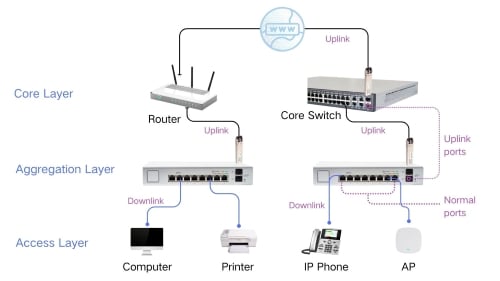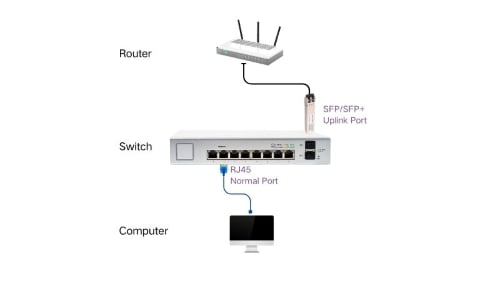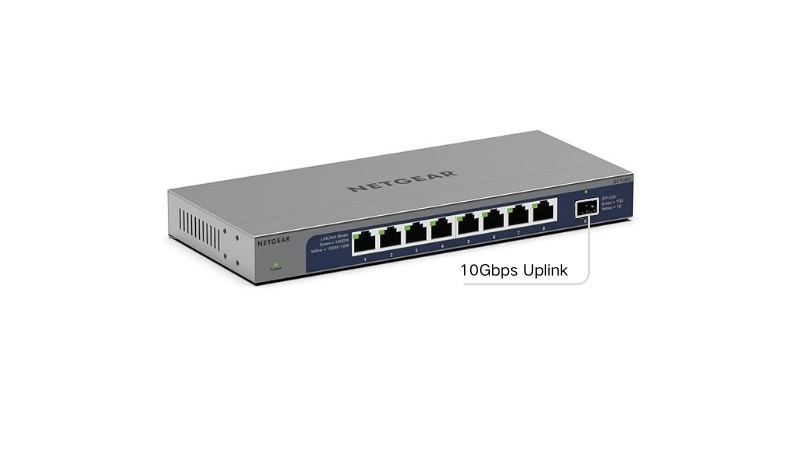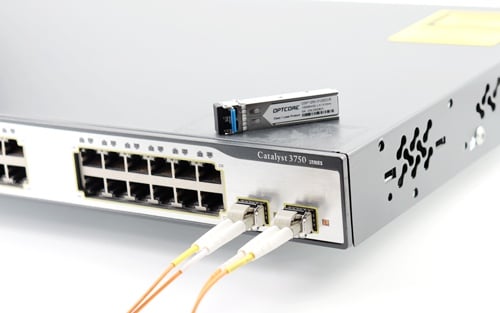Blog, Networking Device
Switch Uplink Port and Normal Port: What is the difference?
You can find both uplink and downlink ports on some switches; what is the difference between them? Whether you are a networking novice or a veteran, knowing the difference between the two types of ports is necessary to manage your network when necessary smoothly. This article will help you differentiate between switch uplink ports and normal ports and guide you when and how to use both types of ports.
What is the Switch Uplink Port
To understand the uplink port, you need first to know the traditional switch topology. A traditional network topology has three layers: core-aggregation-access and an external network connected to the core layer. Moving from the core to the access layer can be seen as moving from “higher” to “lower” layers.
For example, if we upload a photo from our computer to Facebook, the path from us to Facebook’s servers via the Internet is the uplink. In contrast, the path we download a photo from a web page to our computer is the downlink.

So, the uplink port connects the switch to other switches or “higher” layer routers. Additionally, the core-layer switch uplink port connects to the external network. Uplink ports are usually faster than normal ports to handle traffic from multiple devices.
What is the Switch Normal Port
Switch normal ports, also known as downlink or downstream ports, connect access layer devices such as computers, printers, and Access Points. Devices enter and exit the network through these ports. They are also used to connect to the uplink ports of other switches.
If you want to connect your desktop computer to the network, you need to plug its cable into the downlink port of the switch.
Differences Between Uplink Port and Normal Port
Function
The functions of uplink ports and normal ports are different. Uplink ports are designed to connect to other switches, higher-level routers, and public Internet. Normal ports are for connecting access layer devices.
Interface and Fiber Capability
The most common switch normal ports are RJ45 interfaces, while uplink ports are typically SFP or SFP+. Generally, uplink ports’ physical interface is higher than normal ports. For example, a switch with RJ45 downlinks has SFP uplinks, and a switch with SFP downlinks has SFP+ uplinks.

Uplink ports support fiber and copper cables because of the SFP/SFP+ interface. Actually, support or not support fiber is a key distinction between uplink ports and normal ports nowadays. Thanks to Auto-MDI/MDI-X, normal ports can also support uplink connections. So, if the uplink port doesn’t have higher bandwidth, its main specialty is just supporting fiber.
Speed
The normal port speed on commonly used switches has reached 1Gbps, although some are still 100Mbps or lower. Uplink ports often also have a speed of 1Gbps. Additionally, all gigabit ports support auto-negotiation.
However, many switches have uplink ports with higher speeds than normal ports, such as 10Gbps. Because the uplink links of switches must handle more traffic from multiple devices or other switches.

Data Flow Range
The data flow range of uplink and normal port connections is different. If a switch is connected to an external network, the uplink port connection is just like a highway entrance, allowing large volumes of data to move quickly between networks(cities). A normal port connection is like an external city road, where “private” data flows between internal network devices and the switch.
Cable Type
In the past, switches had to use crossover cables to connect downlink ports. Now, crossover cables are rarely necessary, whether they are uplink or downlink ports. Nearly all ports support Auto-MDI/MDI-X, which automatically detects the type of connected device and handles the data crossover.
Therefore, straight-through cables are the preferred connection type, and uplink ports typically use straight-through cables. In fact, uplink ports were specifically designed to cope with the issue of crossover cables.
Redundancy
In large networks, uplink ports are typically used for redundancy rather than normal ports. For example, link aggregation binds multiple ports to build a logical link, increasing theoretical bandwidth. If one link breaks, it can use other active links.
PoE Capability
PoE (Power over Ethernet) is usually on normal ports, while uplink ports typically do not provide PoE. This is because devices that require PoE are mostly connected to the switch’s normal ports. Only a few mini switches might have PoE uplink ports to power themselves.
Can an uplink port be used as a normal port?
Suppose we are not talking about older switches; in most cases, uplink ports and normal ports only differ in physical interface and speed. Even the SFP uplink port and RJ45 normal port have the same speed. So, an uplink port can mostly be used as a normal port. You may just need an SFP/SFP+ to RJ45 cable.
When should I use an uplink port?
Uplink ports offer better network performance and higher scalability but also have higher costs. So, when should you use a switch’s uplink port? The answer is when you need to connect multiple switches or expand the network. For example:
- Connecting two switches: If your switches are located on different floors or areas, you can use the uplink ports to connect them and allow them to communicate with each other.
- Better backbone networks: If you need to configure a high-performance backbone network, you can use multi-gig uplink ports to connect switches to routers or the external Internet.
- Building a larger network: As your network grows and you add more devices or switches, uplink ports become critical to ensure smooth operation and avoid congestion.
Conclusion
In conclusion, uplink and normal ports differ significantly in functionality, speed, and physical interface. Modern regular ports now feature Auto-MDI/MDI-X, making the distinction between uplink ports and regular ports less strict. However, the uplink port is the better choice when higher network performance and scalability are required.
Read More:







